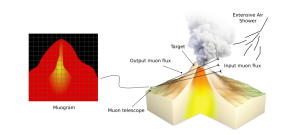Volcano Muography
It is a non-invasive technique for imaging the inner structure of volcanoes (related with the volcano-eruptive evolution) and the magma conduits that give us information about their formation, flanks destabilization, and the internal movement of fluids, which allow us to know and quantify the risk in a possible eruption.
The physical principle behind muography is the same that X-ray radiography, but using muons instead of photons. Firstly, we determine the muon flux attenuation after crossing the volcanic structure. Then, we estimate the material opacity and infer the material average density along the muon trajectory. A particle detector measures the muon flux emerging from the volcano. That allows us to estimate the inner structure by analyzing the density distribution observed in the muogram.
Muons are charged particles like electrons but are 200 times heavier. They are generated in the Earth’s atmosphere by the interaction of cosmic radiation with the gaseous atoms. Muons can travel along rock due to their high penetration capability.
